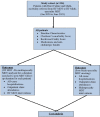Multispecialty multidisciplinary input into comorbidities along with treatment optimisation in heart failure reduces hospitalisation and clinic attendance
- PMID: 35858706
- PMCID: PMC9305818
- DOI: 10.1136/openhrt-2022-001979
Multispecialty multidisciplinary input into comorbidities along with treatment optimisation in heart failure reduces hospitalisation and clinic attendance
Abstract
Aims: Heart failure (HF) is associated with comorbidities which independently influence treatment response and outcomes. This retrospective observational study (January 2020-June 2021) analysed the impact of monthly HF multispecialty multidisciplinary team (MDT) meetings to address management of HF comorbidities and thereby on provision, cost of care and HF outcomes.
Methods: Patients acted as their own controls, with outcomes compared for equal periods (for each patient) pre (HF MDT) versus post-MDT (multispecialty) meeting. The multispecialty MDT comprised HF cardiologists (primary, secondary, tertiary care), HF nurses, nephrologist, endocrinologist, palliative care, chest physician, pharmacist, clinical pharmacologist and geriatrician. Outcome measures were (1) all-cause hospitalisations, (2) outpatient clinic attendances and (3) cost.
Results: 334 patients (mean age 72.5±11 years) were discussed virtually through MDT meetings and follow-up duration was 13.9±4 months. Mean age-adjusted Charlson Comorbidity Index was 7.6±2.1 and Rockwood Frailty Score 5.5±1.6. Multispecialty interventions included optimising diabetes therapy (haemoglobin A1c-HbA1c pre-MDT 68±11 mmol/mol vs post-MDT 61±9 mmol/mol; p<0.001), deprescribing to reduce anticholinergic burden (pre-MDT 1.85±0.4 vs 1.5±0.3 post-MDT; p<0.001), initiation of renin-angiotensin aldosterone system inhibitors in HF with reduced ejection fraction (HFrEF) with advanced chronic kidney disease (9% pre vs 71% post-MDT; p<0.001). Other interventions included potassium binders, treatment of anaemia, falls assessment, management of chest conditions, day-case ascitic, pleural drains and palliative support. Total cost of funding monthly multispecialty meetings was £32 400 and resultant 64 clinic appointments cost £9600. The post-MDT study period was associated with reduction in 481 clinic appointments (cost saving £72150) and reduced all-cause hospitalisations (pre-MDT 1.1±0.4 vs 0.6±0.1 post-MDT; p<0.001), reduction of 1586 hospital bed-days and cost savings of £634 400. Total cost saving to the healthcare system was £664 550.
Conclusion: HF multispecialty virtual MDT model provides integrated, holistic care across all healthcare tiers for management of HF and associated comorbidities. This approach is associated with reduced clinic attendances and all-cause hospitalisations, leading to significant cost savings.
Keywords: Health Care Economics and Organizations; Heart Failure; Outcome Assessment, Health Care; Pharmacology; Quality of Health Care.
© Author(s) (or their employer(s)) 2022. Re-use permitted under CC BY-NC. No commercial re-use. See rights and permissions. Published by BMJ.
Conflict of interest statement
Competing interests: None declared.
Figures




References
-
- GBD 2017 Disease and Injury Incidence and Prevalence Collaborators . Global, regional, and national incidence, prevalence, and years lived with disability for 354 diseases and injuries for 195 countries and territories, 1990-2017: a systematic analysis for the global burden of disease study 2017. Lancet 2018;392:1789–858. 10.1016/S0140-6736(18)32279-7 - DOI - PMC - PubMed
Publication types
MeSH terms
LinkOut - more resources
Full Text Sources
Medical
Research Materials
Miscellaneous
